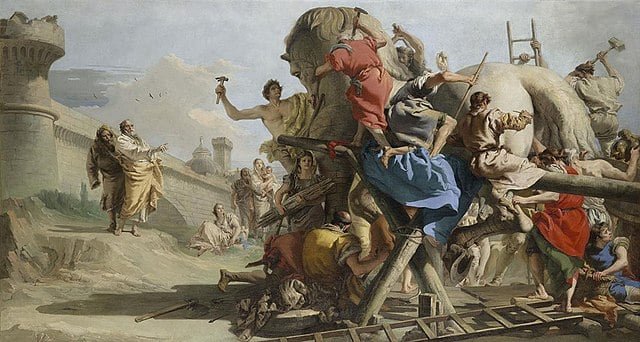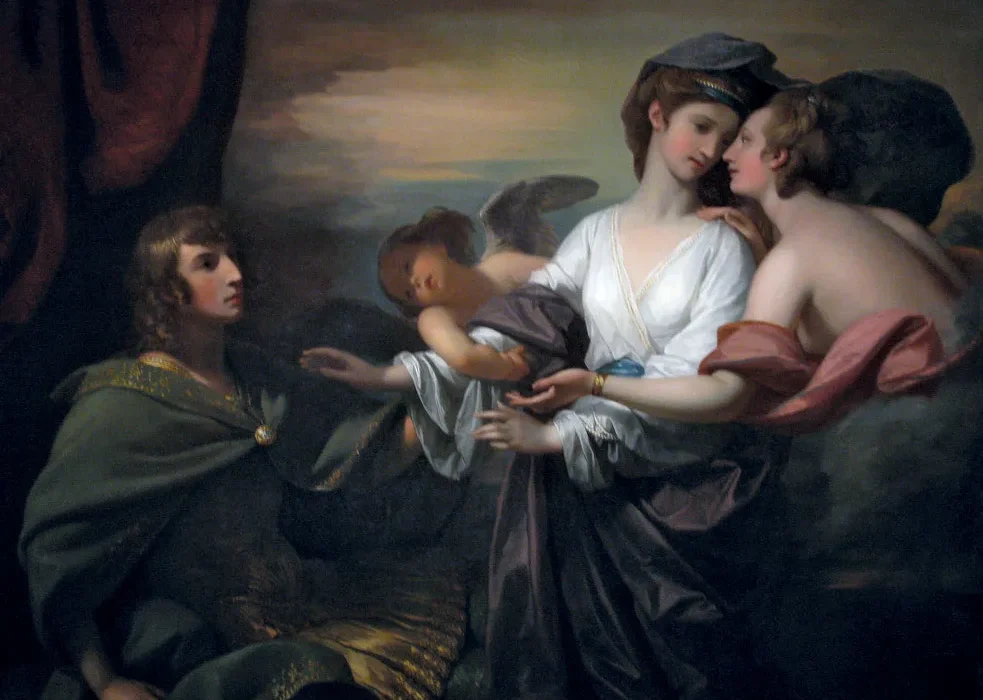There is an image carved deep into the collective imagination of humankind: the city of Troy in flames, its walls collapsing under the fury of war, its people scattered, enslaved, or slaughtered. At its heart, the legendary horse—massive, wooden, hollow, a gift that turned into a curse—stands as one of the most iconic symbols of deception and downfall in all of literature.
But behind this dramatic picture, one question has haunted historians, archaeologists, and storytellers alike: Did Troy really fall, or is it merely a myth born from the poetry of Homer and passed down through centuries of retelling?
The story of Troy lives at the crossroads of myth and history. It belongs equally to the realm of gods and heroes as it does to stone ruins and excavated relics. To search for Troy is to search not only for a city but for the truth behind one of the most enduring tales of Western civilization.
The Trojan War in the Greek Imagination
The fall of Troy comes to us most vividly through Homer’s Iliad and Odyssey, epic poems that have shaped Western literature for nearly three thousand years. The Iliad begins not with the city’s fall, but with rage—the anger of Achilles, the greatest of the Greek warriors. Around this central theme, Homer weaves a story of gods meddling in human affairs, of epic duels, of honor and betrayal, and of the unyielding grip of fate.
Troy, or Ilion as Homer calls it, is portrayed as a proud and mighty city on the western edge of Asia Minor, ruled by King Priam and defended by noble warriors like Hector. Its fate is sealed, however, when Paris, son of Priam, takes Helen, wife of Menelaus of Sparta. What begins as an act of passion—or abduction, depending on the version—ignites a war between Greeks and Trojans that lasts a decade.
The fall itself comes only after years of stalemate. According to the myth, the Greeks resort to cunning where brute strength fails. They construct a giant wooden horse, hollow within, and hide their best warriors inside. Believing it to be a sacred offering, the Trojans drag the horse into their city. That night, under the cover of darkness, the hidden Greeks emerge, open the gates, and allow their army to storm in. Troy falls not through direct conquest, but through trickery.
This story has lived for millennia in countless retellings—by Homer, by Virgil in the Aeneid, by tragedians, by medieval poets, and by modern authors and filmmakers. But the myth raises the question: how much of this tale is history, and how much is artful invention?
Troy on the Map: Searching for a Lost City
For centuries, Troy was considered more legend than fact, a city born of imagination rather than stone. That changed in the 19th century when an eccentric German businessman named Heinrich Schliemann set out to find the ruins of Troy. Guided by his belief that Homer’s epics reflected actual events, Schliemann excavated a mound in modern-day Turkey known as Hisarlik.
There, he unearthed the remains of multiple ancient settlements stacked on top of one another, like layers of history compacted into earth. He claimed to have found the true Troy and even spoke of discovering “Priam’s Treasure.” Though his methods were crude and often destructive, Schliemann set in motion a debate that continues to this day.
Later excavations refined the picture. Archaeologists revealed not one city, but a succession of cities built and rebuilt over thousands of years. Among them, Troy VI and Troy VII, dating roughly to the Late Bronze Age (around 1700–1200 BCE), showed signs of destruction. Massive walls, evidence of fire, and remains of siege warfare suggested that these cities could indeed have been the Troy of legend.
While the exact identity of the people who lived there remains debated, Hisarlik is now widely accepted as the site of ancient Troy. The question, however, is not only whether Troy existed, but whether its fall was anything like the stories told by Homer.
Between Archaeology and Epic Poetry
To unravel the mystery, we must compare archaeology with literature. The Iliad, while rich in detail, was composed centuries after the supposed events of the Trojan War. Scholars believe the epic was shaped by oral traditions passed down through generations, blending kernels of truth with layers of embellishment, myth, and invention.
Archaeology tells us that Troy VI was a large, wealthy city with formidable defenses. It stood at a strategic location controlling access to the Dardanelles, a vital waterway connecting the Aegean Sea to the Black Sea. This made it a prize for any power seeking to dominate trade and military routes. Around 1250 BCE, Troy VI suffered destruction, possibly from an earthquake. Soon after, Troy VII rose, only to be violently destroyed around 1180 BCE, coinciding with the period of upheaval known as the Bronze Age Collapse.
These findings suggest that a major conflict or series of conflicts indeed took place in the region during the time traditionally associated with the Trojan War. Yet the wooden horse, Achilles’ wrath, and the meddling of gods belong more to storytelling than to the archaeologist’s spade.
The Wooden Horse: Symbol or Reality?
Perhaps no element of the Trojan War is more famous—or more puzzling—than the Trojan Horse. Did such a contraption ever exist, or is it pure allegory?
Some scholars suggest the horse may represent a metaphor for siege technology, perhaps a battering ram or war machine shaped like a horse. Others argue it may symbolize an earthquake (since horses were associated with Poseidon, god of earthquakes), suggesting that a natural disaster, not a trick, breached Troy’s walls. Another possibility is that the horse is a later poetic invention, a dramatic symbol of cunning triumphing over brute force.
Whether real or imagined, the horse endures because it captures something timeless: the danger of misplaced trust, the thin line between victory and ruin.
A War of Trade and Power
Beyond myth, historians have sought practical reasons for a war at Troy. The city’s location was not merely picturesque—it was strategic. Standing near the entrance to the Dardanelles, Troy controlled a chokepoint of immense economic and military importance. Whoever ruled Troy could influence trade between the Aegean and the Black Sea, as well as access to vital resources such as grain, metals, and timber.
It is possible that what Homer remembered as a war for Helen was, in historical terms, a conflict over trade routes and political dominance. This would align Troy with countless other Bronze Age wars fought for territory, resources, and prestige.
The Wider Collapse of the Bronze Age
The destruction of Troy cannot be understood in isolation. Around 1200 BCE, civilizations across the eastern Mediterranean fell into crisis. The Hittite Empire, Egypt’s rivals in Anatolia, collapsed. Mycenaean palaces in Greece were abandoned. Cities across the Levant burned. This period, known as the Bronze Age Collapse, remains one of history’s great enigmas.
The fall of Troy may have been part of this larger upheaval—a single thread in a tapestry of migrations, invasions, and natural disasters that reshaped the ancient world. The war that Homer immortalized may thus reflect a real conflict, magnified through generations of storytelling, set against the backdrop of a world in turmoil.
Myth as Memory
Even if we strip away the divine interventions and heroic duels, what remains is striking: a memory of a great war at a great city, preserved through oral tradition for centuries before Homer gave it literary form.
This raises a profound question: Can myth be a vessel of history? While myths distort, embellish, and dramatize, they often preserve a kernel of truth. They capture the emotional reality of an event even when they exaggerate its factual details. The fall of Troy may have been less about a single wooden horse and more about siege, famine, or betrayal. Yet the story resonates because it captures universal themes of love, pride, greed, and the tragic cost of war.
Troy’s Legacy in Literature and Culture
Whether myth or history, the fall of Troy has shaped culture for millennia. Virgil’s Aeneid cast the Trojans as ancestors of the Romans, giving Rome a heroic past. Medieval Europe reimagined the Trojans as the founders of noble dynasties. In modern times, Troy has inspired novels, plays, films, and even video games.
Its themes are eternal. The cunning trick of the horse is retold as a warning against hidden dangers. The love of Paris and Helen becomes a symbol of desire and destruction. The heroism of Hector and the rage of Achilles embody timeless struggles of duty, pride, and mortality.
Troy is not just a city—it is a mirror in which every age sees its own anxieties, ambitions, and tragedies reflected.
The Border Between Myth and History
So, was the fall of Troy myth or history? The answer lies not in one or the other, but in the blurred line between them.
Archaeology proves that a powerful city stood at Hisarlik and that it was destroyed in the Late Bronze Age. History suggests that wars over trade and power could easily have centered on such a place. Myth transforms these events into something larger than life, adding gods, heroes, and moral lessons.
The fall of Troy is thus not just a historical event or a literary tale—it is both. It is history remembered through the prism of poetry, myth shaped by the echoes of real wars.
The Enduring Allure of Troy
More than three thousand years after its supposed fall, Troy still burns in our imagination. It burns not because of certainty, but because of mystery. In its ruins, we see both the fragility of civilizations and the endurance of stories. In its myths, we glimpse both the creativity of human imagination and the faint traces of historical truth.
Troy reminds us that history and myth are not enemies but companions. Myth keeps history alive in memory and emotion, while history grounds myth in the soil of reality. Together, they give us a richer understanding of who we are, of the wars we fight, and of the stories we tell to make sense of them.
The fall of Troy, then, is more than the destruction of a city. It is the triumph of story over oblivion. Whether myth or history—or both—it remains one of the great narratives of humanity, a tale where stone and song meet, where archaeology and poetry embrace, and where the flames of an ancient city still illuminate the human spirit.





